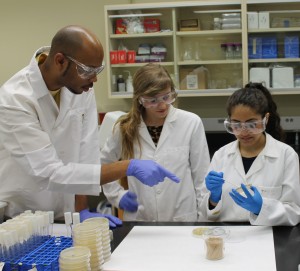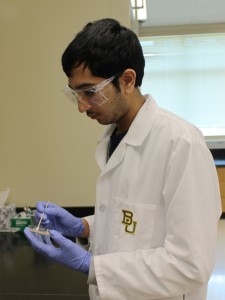
Michael Cotten (left), a graduate student in biology, looks on as undergraduates Shelby Armstrong and Shanze Zar examine a petri dish containing isolates found in soil samples.
For most patients, hospitals are very safe environments in which to receive treatment and recover. However, despite hospitals’ best efforts, some patients, especially those with compromised immune systems, may be at risk of contracting dangerous infections. A particular group of germs called E.S.K.A.P.E. pathogens — named for the Enterococcus faecalis, Staphylococcus aureus, Klebsiella pneumonia, Acinetobacter baumanii, Pseudomonas aeruginosa, and Enterobacter bacteria — has become a growing concern for health care providers, because the pathogens have adapted to develop a resistance to current antibiotics. According to the American Center for Disease Control and Prevention, in the United States, 19,000 patients die every year from an infection caused by an E.S.K.A.P.E. pathogen. The problem of today’s antibiotics failing to combat pathogens that have grown a resistance to them is a serious one and one that a group of Baylor undergraduate students and their faculty mentors have devoted time and effort toward solving.
Dr. Diane Hartman, lecturer of biology, and students in her Biology Small World Initiative class have accepted the surmounting challenge of discovering new bacteria which can combat the antibiotic-resistant pathogens found in hospitals by adopting the principle of getting back to the dirt.
“This project all started when we received an email two summers ago from Yale stating that they had just completed a year of the small world initiative, where they had been sampling soil to find antibiotic producing microbes,” Hartman said. “They sent out a request for pilot partners who would be interested in going to Yale over the summer to train so their universities could offer this kind of course to expose freshman and sophomore students to hands-on research early in their collegiate careers.”
Baylor is currently the only university in Texas partnered with Yale in the project. The course offers under-classmen a chance to aid the process of finding a solution to one of modern medicine’s most costly problems.
“Currently, the problem is that most of our antibiotics are synthesized and re-engineered forms of bacteria that were discovered years ago, so common pathogens found in hospitals have begun to grow immune to the antibiotics currently being produced,” sophomore pre-biology major Elizabeth Andersen said. “Our mission was to go back to nature to try to discover new bacteria that can fight today’s E.S.K.A.P.E pathogens.”
In order to find new bacteria microbes, the students simply had to go out and dig. Groups of students went to separate locations across Waco and gathered soil samples which they then tested, looking for microbes that could potentially slow the growth of the E.S.K.A.P.E. pathogens. This process proved to be rewarding for some groups and difficult for others.
“The only problem that befell our group was after finding what we thought was a nutrient rich soil sample from Cameron Park, the sample had only four isolates out of the 18 microbes identified,” junior Biology major Patel said.

Ohm Pandya, a junior biochemistry major, prepares a sample as part of the Biology Small World Initiative class.
According to junior biology major Shelby Armstrong, “Our group having 12 isolates, the highest out of all the soil samples, was surprising, but it was rewarding because there were so many more tests we could run and pathogens that we could compare those bacteria to.”
Several students who took the class the first time it was offered last year have returned this fall to continue their research and to acquire more molecular identifications before they submit their results and microbe samples to Yale, where other researchers will perform further analysis to determine if the bacteria show promise for future drug development.
“We are entering what scientists are calling the post antibiotic era,” said senior lecturer of biology Dr. Jacquelyn Duke. “The pathogens that medicine was able to treat for years with the same antibiotics are now growing resistant. This type of research may provide the next generation of antibiotics, but it is an ongoing process. Pathogens will continue to build up resistance over time, so science and medicine have to constantly be pursuing new avenues to fight infections.”
Aside from submitting their work to collaborators at Yale, students in the class have had other opportunities to showcase their research. The entire class was able to participate in URSA Scholars Week in the spring of 2014 and many attended and presented their work at the Texas Society of Microbiology meeting. Andersen received funding from Yale to present at the American Society of Microbiology meeting in Boston this past May.
Students who are participating in this research say the experience has impacted their lives in a variety of ways. Some students from the original class have returned as mentors for the current class. Others said that it influenced their future career plans.
“We all plan on continuing to research in the future,” Andersen said. “One thing I’ve learned about research is that you are never truly done; there will always be more questions and problems that arise and as a scientist, you want to continue the process and address them as time goes on.”
This story is part of a series of undergraduate research highlights by Caleb Barfield, a student worker in the Office of the Vice Provost for Research. Caleb is a sophomore from Denton majoring in journalism, new media and public relations. Click here to read more of his work.
